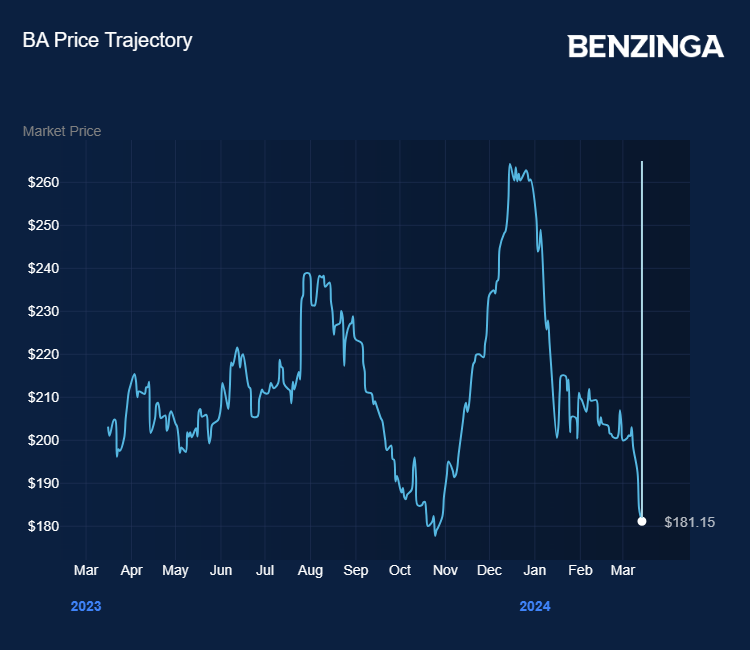Zinger Key Points
- Around 50 passengers were injured on the LATAM flight from Sydney to Auckland.
- Could a flight attendant have hit a button that pushed the pilot's sear forward into the controls?
- Feel unsure about the market’s next move? Copy trade alerts from Matt Maley—a Wall Street veteran who consistently finds profits in volatile markets. Claim your 7-day free trial now.
Aerospace manufacturer Boeing Co BA might be able to cross off one of this week’s in-flight incidents as “not our fault.”
When a LATAM flight went into a terrifying nosedive, it may have been due to a “cockpit seat mishap,” according to a late Thursday report from U.S. aviation industry officials.
Around 50 passengers were injured on the LATAM flight from Sydney to Auckland after the plane suddenly and rapidly descended, officials briefed on the initial findings say.
Some, who hadn’t been wearing their belts, were thrown to the ceiling of the cabin.
Boeing — which manufactured the 787 Dreamliner involved in the LATAM incident — was, again, in the spotlight, but not at fault.

A Moving Seat Issue?
Per the the Wall Street Journal, a flight attendant mistakenly hit a switch on the pilot’s seat while serving a meal causing the seat to move forward and push him into the controls that pushed the plane’s nose down.
The switch in question usually has a cover and is only supposed to be used when the plane is on the ground and there is no pilot in the seat.
Boeing Under Investigation
Boeing was already under intense scrutiny since January.
Shares in the company have plunged 30% since the start of the year, with most of the losses coming in the two weeks following the Alaska Airlines ALK incident, when a door panel blew out on a Boeing 737 Max 9 jet, forcing the flight into an emergency landing.
Thankfully, the incident occurred shortly after take-off from Portland while the plane was climbing, so all passengers were still wearing seat belts and no one was seriously hurt.
Initial findings from the official safety investigation into Boeing following the Alaska Airlines incident were reported this week and showed that Boeing failed 33 out of 89 audits carried out by the Federal Aviation Administration.
‘Cockpit Mishap’ Comments
But could a cockpit mishap have caused such mayhem on a flight? The social media commentators were skeptical.
Gary Howard, a consulting engineer, wrote on X: “Makes no sense. The plane would have been on autopilot at that point in the flight.”
The Acerbic Aviator, a trained pilot familiar with Boeing planes, wrote: “It is uniquely unlikely that a flight attendant located a toggle or lever on the seat that caused the seat to rapidly slide forward. I’ve flown Boeing products. There is something missing from this.”
In initial reports, LATAM had suggested “technical problems” were responsible for the dive, but in later official statements it described the incident as a “strong shake” and added, “the cause of which is under investigation.”
Airline Stocks Down
Airline stocks have been among the worst performing in the past month — some of that can be attributed to Boeing, following the grounding of the Max 9 fleet after the Alaska Airlines incident.
Southwest Airlines Company LUV has fallen 18% in the past week after it said it would have to issue new 2024 guidance as it awaited fresh deliveries from Boeing. American Airlines Group AAL has lost 5% this week.
The U.S. Global Jets ETF JETS, an exchange traded fund that holds all the above airline groups, as well as Delta Air Lines Inc. DAL and United Airlines Holdings Inc. UAL and other, is down 2.7% this week.
Now Read: Boeing Shares Tumble After FAA Investigation Fails 33 Out Of 89 Audits
Image via Shutterstock
Edge Rankings
Price Trend
© 2025 Benzinga.com. Benzinga does not provide investment advice. All rights reserved.
Trade confidently with insights and alerts from analyst ratings, free reports and breaking news that affects the stocks you care about.